Norman Rockwell’s Iconic Four Freedoms
To Travel in Seven-City International Tour
Enduring Ideals: Rockwell, Roosevelt
& the Four Freedoms
Opens at New-York Historical Society on May 25, 2018
Exhibition travels across US. and to Normandy, France,
before culminating in 2020 at Norman Rockwell Museum, in Stockbridge, MA
First comprehensive examination of Rockwell’s 1943 paintings highlights their role as agents of change, uniting the public in defense of universal human rights

In May 2018, the first comprehensive exhibition devoted to Norman Rockwell’s iconic depictions of FDR’s Four Freedoms—Freedom of Speech, Freedom of Worship, Freedom from Fear and Freedom from Want—begins its international tour in New York City. Opening at the New-York Historical Society on May 25, Enduring Ideals: Rockwell, Roosevelt & the Four Freedoms explores how the 1943 paintings came to be embraced by millions of Americans, providing crucial aid to the War effort and taking their place among the most indelible images in the history of American art. It is, in effect, the story of how the images were transformed from a series of illustrations into a national movement that united the country behind a common cause.
The exhibition, which provides a rare opportunity to see Rockwell’s images together outside their permanent home in Stockbridge, Massachusetts, will illuminate both the historic context in which FDR articulated the Four Freedoms and the role of Rockwell’s paintings in bringing them to life for millions of people, changing the tenor of the times. It will additionally show how the Four Freedoms paintings were precursors to a sequence of works spanning three decades in which Rockwell addressed significant social concerns, from civil rights to the nation’s role and responsibilities at home and abroad.
Enduring Ideals: Rockwell, Roosevelt & the Four Freedoms and its seven-city tour (see page six) are organized by the Norman Rockwell Museum. The exhibition has been co-curated by Stephanie Haboush Plunkett, Deputy Director and Chief Curator, Norman Rockwell Museum, and James J. Kimble, Ph.D., Associate Professor of Communication & the Arts, Seton Hall University. Additionally, a National Advisory Board, comprising scholars, artists, and museum professionals, has provided guidance and expertise for the exhibition.
Norman Rockwell Museum Director Laurie Norton Moffatt noted, “Enduring Ideals: Rockwell, Roosevelt & the Four Freedoms will show how Rockwell’s aspirational paintings shifted American attitudes towards engagement in the War in defense of the free world, and, ultimately, helped to make the case for universal human rights. In doing this, the exhibition reveals the enduring power of illustration to communicate ideas and inspire change. Moreover, in highlighting Rockwell’s and his generation’s response to the call for unity in support of these fundamental freedoms, the exhibition resonates powerfully with our own time. We are delighted to have organized Enduring Ideals: Rockwell, Roosevelt & the Four Freedoms and are deeply grateful to our exhibition supporters, who have enabled us to develop this project, and to the five museums that will make this exhibition their own.”
Support
Leadership support for Rockwell, Roosevelt & the Four Freedoms is provided by Jay Alix, The Alix Foundation and the George Lucas Family Foundation. National presenting sponsor is The Travelers Companies, Inc. Major support provided by Anonymous, Michael Bakwin, Helen Bing, Elephant Rock Foundation, Ford Foundation, Heritage Auctions, Annie and Ned Lamont, National Endowment for the Arts, and Ted Slavin. Media sponsors: Curtis Licensing, a division of The Saturday Evening Post, and Norman Rockwell Family Agency.
Exhibition Overview
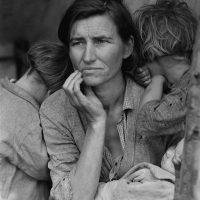
The War Generation
The exhibition opens with a look at the political and socio-economic backdrop against which Roosevelt articulated the Four Freedoms. A recording of one of Roosevelt’s famous Fireside Chats, this one from April 14, 1938, will enable visitors to hear about the nation’s problems from the president himself. Primary among these, of course, were the crushing struggles of the Great Depression, conveyed here through displays that include a newsreel showing breadlines; a rich selection of photographs of Americans toiling to survive, by Walker Evans, Gordon Parks, Arthur Rothstein, and others; and a powerful historic photograph of a billboard that warns “Jobless men keep going. We can’t take care of our own.”
The War Generation will also bring to light the growing preoccupation with enumerated freedoms during this era, when—as evidenced by a group of documentary photographs—war in Europe and Asia was an ominous undercurrent. Sculptor Leo Friedlander’s monumental embodiments of freedom of speech, assembly, press, and religion, created for the 1939 New York World’s Fair, are seen here in photographs, while Roosevelt is shown with a group of reporters at Hyde Park in the summer of 1940, holding an off-the-record conversation about various types of freedom. Finally, a series of widely circulated original illustrations by Rockwell, Leyendecker, Al Parker, and others speak to society’s core beliefs and reflect their moment in time.
FDR’s Freedoms
President Roosevelt understood that the nation—still wearied by not only the Great Depression but also the First World War—would have to go to war once again, and that there was likely to be little public appetite to do so. The next section of the exhibition, FDR’s Freedoms, turns to Roosevelt’s emphatic proclamation of the Four Freedoms as a reason to enter the War, presented in his 1941 address to congress. Given on January 6—just 11 months before the U.S. joined the War—the speech is examined through the seven drafts that Roosevelt worked on (with the Four Freedoms making their appearance in the fourth) before making the speech.
Neither the speech nor the subsequent incorporation of the Freedoms into the Atlantic Charter—evoked here through photographs and documents—was able to rally the nation behind the War. Nor were such promotional items as posters, pamphlets, a Four Freedoms matchbook, or other ephemera, a selection of which is on view here.
This section also includes a variety of war-related artworks, including drawings and published illustrations by Rockwell and others. Rockwell himself rarely depicted the war directly, opting instead for images of the home front. Among the examples on view will be depictions of Willie Gillis, the artist’s fictional wartime G.I., and other images intended to gain support for the war effort, including examples by Mead Schaeffer and other prominent illustrators.
Artistic Response to the Four Freedoms Ideals
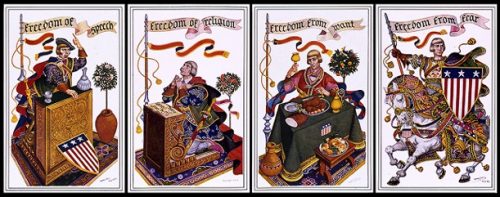
The next section of the exhibition documents the government’s efforts to promote the ideals to the public by encouraging artists across disciplines to interpret Roosevelt’s Freedoms. Artistic Response to the Four Freedoms Ideal includes a range of tributes to the Freedoms in the form of sculpture, paintings, prints, drawings, quilts, stamps, a symphony, and even a printed commercial textile. Unfortunately for FDR, none of these efforts compellingly depicted the Four Freedoms—whether artworks that take on the aesthetic and imagery of Medieval manuscript illuminations or Expressionist, Surrealist, or Social Realist art by Arthur Szyk, Ben Shahn, Hilda Katz, and others—frustrating the president’s attempts to build consensus behind the Freedoms.
Rockwell’s iconic 1943 paintings Rosie the Riveter and Liberty Girl, affirmations of the important role that American women played during World War II, are here, as is his Refugee Thanksgiving, from the same year, a starkly different scene than the Thanksgiving dinner depicted in Freedom from Want, the most widely known of his Four Freedoms images
A group of powerful World War II propaganda posters in this section includes examples that addressed life on the home front (“Grow your own. Can your own,” “Find your war job”), and were intended to rally support for the troops and remind the public of its civic duty. These are supplemented by a selection of contemporaneous German, Italian, and Japanese examples.
Rockwell’s Four Freedoms
This section tells the story of Rockwell’s interpretation of President Roosevelt’s Four Freedoms and how, thanks largely to their reproduction in The Saturday Evening Post, they would come to be embraced by millions, touring the United States and, as stated in the New Yorker magazine in 1945, “received by the public with more enthusiasm, perhaps, than any other paintings in the history of American art.”*
By the time Rockwell focused on the Four Freedoms as a subject, he had already worked with the Ordnance Department of the U.S. Army to support the war effort, creating a painting of a machine gunner in need of ammunition. Reproduced on posters featuring the exhortation “Let’s Give Him Enough and On Time,” it was distributed to ordnance plants across the country to encourage production.
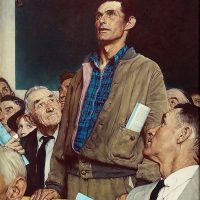
But Rockwell wanted to do more, and he determined that images of FDR’s Four Freedoms were the way to achieve this. In the summer of 1942, he traveled to Washington, D.C., drawings in hand, to propose the idea to the Ordnance Department, but they did not have the resources for another commission. On the way back to his home in Vermont, he stopped at Curtis Publishing Company, publisher of The Saturday Evening Post, where editor Ben Hibbs immediately made plans to reproduce the works in the Post, instructing Rockwell to drop his other work for the magazine in order to complete the paintings.
Once commissioned, Rockwell found himself challenged to find a way to translate the president’s lofty ideals into something that would touch the daily lives—and hearts—of average American citizens. While struggling to find a solution, he happened to attend a local town-hall meeting at which a man stood up to voice an unpopular view. It was then that Rockwell realized that he could best paint the
* Rufus Jarman, “Profiles,” The New Yorker, March 17, 1945, p. 34.
freedoms from the perspective of his own hometown experiences, using everyday scenes like that town meeting. It was a simple solution that turned out to be the key to transformational change.
As attested here by preliminary concepts for Freedom of Speech (the interpretation of the scene Rockwell
had witnessed in the town-hall meeting) and Freedom of Worship, Rockwell struggled to develop his
compositions. Yet some six months later, they were reproduced in four sequential issues of the Post in February and March 1943, all on view in the exhibition. Each Freedom was accompanied by an essay by a
distinguished writer—Booth Tarkington on Freedom of Speech; Will Durant on Freedom of Worship; Carlos Bulosan on Freedom from Want, and Stephen Vincent Benét on Freedom from Fear.
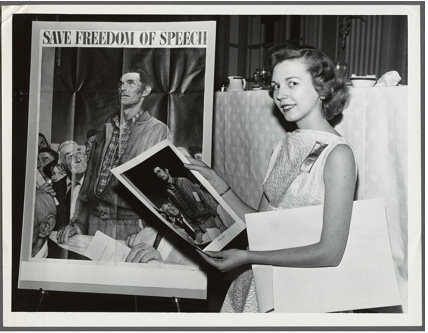
Rockwell’s images immediately became inseparable from Roosevelt’s Four Freedoms in the public imagination, and in April 1943, the paintings went on a 16-city tour on behalf of the sale of war bonds. In testimony to the power of these readable images of average men and women, composed to suggest an inherent story, the exhibition was hugely successful, bringing the ideals of the Four Freedoms to 1.2 million people and yielding $132 million in war-bond sales, with reproductions of the paintings offered as a premium for purchase. The tour is represented here by a newsreel of Rockwell with his models for the series, letters from prominent figures, a variety of photographs, and diverse ephemera.
The government printed four million posters of Rockwell’s Four Freedoms during the war. Today they continue to be among the artist’s most reproduced and even parodied images—on art posters, in textbooks, and in a range of commercial goods.
Freedom’s Legacy
Enduring Ideals: Rockwell, Roosevelt & the Four Freedoms concludes by following the post-war outcomes of Roosevelt’s Four Freedoms. From their adoption by the United Nations to their incorporation into national constitutions, to the ways in which they inspired figures of international renown, the Four Freedoms ideals have been embraced throughout the world and continue to resonate profoundly today.
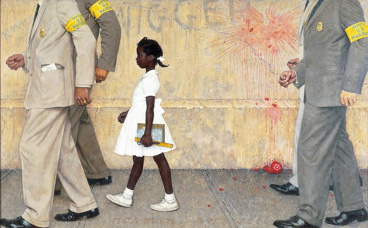
Central to this section of the exhibition is Rockwell’s ongoing focus on the theme of human rights, bringing his Four Freedoms paintings to the post-war era. In 1952, at the height of the Cold War and two years into the Korean War, he conceived an image of the United Nations as the world’s hope for the future. His appreciation for the organization and its mission inspired a complex composition portraying members of the Security Council and more than 50 people representing the nations and cultures of the world—a study for an artwork that he originally intended to complete in painted form. Though the drawing never actually made it to canvas, his desire to emphasize the commonality of mankind found its forum nine years later, in 1961, on the reproduction of his painting Golden Rule on the cover of The Saturday Evening Post. Both the painting and the earlier sketch are in the exhibition, as are other influential civil rights-era works. These include his 1963 painting The Problem We All Live With, a gentle yet powerful assertion of moral decency. Rockwell’s first assignment for Look magazine, it shows a six-year-old African American schoolgirl being escorted by four U.S. marshals to her first day at an all white school in New Orleans. The painting was inspired by the story of Ruby Bridges, the first African American child to integrate New Orleans’ William Frantz Elementary School. Studies and photographic references for this important painting are also on view.
In the late 1960s, growing dissent against the Vietnam War fueled Rockwell’s painting The Right to Know, a strong political statement about the need for government transparency and the right of American citizens to be informed of its actions. Composed in the style of the Golden Rule, this powerful 1968 painting for Look will also be among the works exploring global and political themes.
Freedom’s Legacy also spotlights the efforts of Eleanor Roosevelt to advance the Four Freedoms ideals in the United Nations Declaration of Human Rights, and the heroic efforts of the recipients of the Franklin D. Roosevelt Four Freedoms Awards. Works of social commentary created by other noted artists are also here, and visitors will be invited to record their own reflections on freedom.
Reimagining the Four Freedoms
In early 2017, the Norman Rockwell Museum distributed a call to artists working in any medium or discipline to create a work that reimagines the Roosevelt’s Four Freedoms, expressing their relevance to the present day. Approximately 30 works have been selected by a specially convened jury. Each venue will present the works in its own way, whether as a section of the exhibition or, in the case of the New-York Historical Society, as a companion presentation, to be held at The Roosevelt House. Support for the juried exhibition has been sponsored by the Ford Foundation.
Exhibition Tour
To date, the exhibition tour comprises The New-York Historical Society, New York City, NY, May 25 – September 2, 2018; The Henry Ford, Dearborn, MI, October 13, 2018 – January 13, 2019; The George Washington University Museum and The Textile Museum, Washington, D.C., February 9 – May 6, 2019; Mémorial de Caen, Normandy, France, June 4 – October 27, 2019; Museum of Fine Arts, Houston, TX, December 15, 2019 – March 22, 2020; Venue to be Announced, July 4 – September 20, 2020; and Norman Rockwell Museum, Stockbridge, MA, fall 2020.
Catalogue
The exhibition is accompanied by a fully illustrated catalogue featuring essays on a range of related
cultural and artistic themes by distinguished scholars, curators, and noted public figures. The list of
contributors includes: Dr. Kimble and Ms. Haboush Plunkett; Brian Allen, Ph.D., former curator at the Sterling and Francine Clark Art Museum and former director of Addison Gallery of American Art; Allida Black, Research Professor of History and International Affairs at The George Washington University, and founding editor of The Eleanor Roosevelt Papers, a project designed to preserve, teach and apply Eleanor Roosevelt’s writings and discussions of human rights and democratic politics; Ruby Bridges, American activist known for being the first black child to desegregate the all-white William Frantz Elementary School in Louisiana during the New Orleans school desegregation crisis in 1960; Douglas B. Dowd, professor of art and American culture studies, Washington University in St. Louis; Jan Eliasson, a Swedish and international diplomat who served as Deputy Secretary-General of the United Nations from 2012 to 2016; Stéphane Grimaldi, Director, Memorial de Caen, France, where he has served for the past thirteen years; Harold Holzer, Jonathan F. Fanton Director of The Roosevelt House Public Policy Institute at Hunter College in New York City; Harvey J. Kaye, Ph.D., professor of democracy and justice studies, University of Wisconsin, Green Bay; James McCabe, chief collections manager/curator of buildings, the Henry Ford; Laurie Norton Moffatt, director of the Norman Rockwell Museum; Lester C. Olson, chair, professor of communication, and Chancellor’s Distinguished Teacher, University of Pittsburgh; Daisy Rockwell, Ph.D., author and granddaughter of Norman Rockwell; Ramón Saldívar, professor of English and Comparative Literature and the Hoagland Family Professor of Humanities and Sciences at Stanford University, was awarded the National Humanities Medal by President Barack Obama in 2012; and Mark R. Schulman, Ph.D., who served as editor-in-chief of the Journal of Transnational Law at Columbia and recipient of the Berger Prize for international law; Irvin Ungar, a former pulpit rabbi and antiquarian bookseller; and Ambassador William vanden Heuvel, chairman emeritus of the Franklin D. Roosevelt Four Freedoms Park, LLC, chairman and chief executive officer of Four Freedoms Park Conservancy, Inc., and founder and chair emeritus of the Franklin and Eleanor Roosevelt Institute.
Related Programming
Enduring Ideals: Rockwell, Roosevelt & the Four Freedoms will be enriched by a full roster of programs and
activities for the public, students, and teachers. Examples include an accompanying audio-visual tour—
downloadable on personal devices within or beyond the walls of hosting venues—that features diverse perspectives on imagery and themes, with reflections by a range of artists, scholars, authors, curators, and leaders in the realm of politics and diplomacy.
Other activities and programs will include: a digital gallery tour that will be accessible by mobile devices; a comprehensive online teachers’ curriculum collaborative; a family guide to the exhibition; a national social-media campaign engaging audiences of all ages; and an extensive online media hub encompassing podcasts, interviews, lectures, and student galleries, among other projects. The digital learning and enhancement for the exhibition is made possible by a grant from the George Lucas Family Foundation.
Collaboration on Virtual Reality Component
In a unique collaboration, the exhibition’s virtual reality experiences are being designed and developed in partnership with teachers and students in the Game Design School at the Academy of Art University, San Francisco. Using Rockwell’s Four Freedoms paintings as points of inspiration, these innovative VR experiences promise to engage viewers with art and the historical moment in unique and unexpected ways.
About Norman Rockwell Museum
The Norman Rockwell Museum is dedicated to education and art appreciation inspired by the legacy of Norman Rockwell. The Museum holds the world’s largest and most significant collection of art and archival materials relating to Rockwell’s life and work, while also preserving, interpreting, and exhibiting a growing collection of art by other American illustrators throughout history. The Museum engages diverse audiences through onsite and traveling exhibitions, as well as publications, arts and humanities programs, and comprehensive online resources.
The Museum’s recently established Rockwell Center for American Visual Studies supports sustained scholarship in American illustration. The first program of its kind in the nation, the Rockwell Center places the Museum in the vanguard of the preservation and interpretation of published imagery, a critically important but understudied aspect of American visual culture.
The Norman Rockwell Museum advances social good through the civic values of learning, respect, and inclusion, and is committed to upholding the rights and dignity of all people through the universal messages of humanity and kindness portrayed by Norman Rockwell. https://www.nrm.org/
###
Media Contacts
Alyssa Stuble
Communications Manager
presscontact@nrm.org


